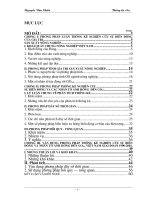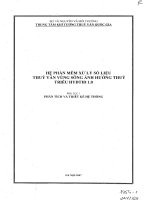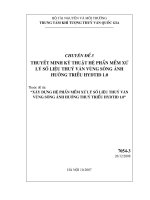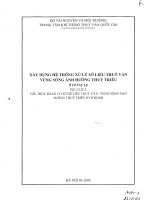ảnh hưởng của hành vi khách hàng đến việc kiểm soát cảm xúc và sự hài lòng trong công việc của nhân viên
Bạn đang xem bản rút gọn của tài liệu. Xem và tải ngay bản đầy đủ của tài liệu tại đây (165.98 KB, 5 trang )
Mai Viet Aiib
Tap chi KHOA HpC & CONG NGHE
152(07)/2:29-33
THE EFFECT OF CUSTOMER'S BEHAVIORS ON EMPLOYEE'S
EMOTIONAL REGULATION AND JOB SATISFACTION
Mai Viet Anh
College of Economics and Business Admlnlslralton - TNU
SUMMARY
In service process customer's attitades and behaviors mfluence employee's emoUon Customers
S„nl2"
^ ^ ™ , " '•°''°"" " " " " ^ '° ™P"»'»^ "iy •»'*= employees r r
That may affect service quality dial servicefirmsprovide to customers. This paper smdies the
INTRODUCTION
In service process, customer and employee
have to interact with each other. Therefore,
customers' attitudes and behaviors affect
employees' emotions and then affect service
quality. Customers with unsuitable attitudes
or behaviors may make employees angry and
employees may lose their control and do not
follow organizational rules. Most of previous
studies focused on identify the effect of
employees' attitudes affect customers'
emotions. Some research has clarified the
employees' emotion regulation in service
process. However, there is no study that study
the efftct of customers' behaviors on
employees' emotion regulation and job
satisfilction. When understanding diis effect,
servicefirmsmay implement some solutions to
improve the interaction between customers and
employees in service process, improve service
quality, increase customer satisfilction.
THEORETICAL
BACKGROUD AND
HYPOTHESES
Customer Injustice Behaviors
Customers' injustice refers to unfairness or
insensitivity displayed when customeis treat
unfairly widi employees. Affective event
theory posits that specific event it work
generate specific emotions, which in turu
Td: 09SS mm.
Email Vleianh®n,eba edu.vn
translate to spontaneous, affectively driven
behaviors such as organizational citizenship
behavior and work withdrawal. One class of
affective events includes situations where
individuals feel they are treated unfairly.
According to affective event dicoiy, customers'
injustice creates negative emotions in
employees. Wlien employees are treated rudely
or mipolitely by customers, it is easy for them to
experience^egative emotions.
Anger Felt
Anger Fch refers to emotional state that
employees really dissatisfy with something or
with other people's behaviors. The feelings of
employees may show the level of emotions
such as happy, dissatisfaction, angry, mad,
and crazy. When employees being treated
unfairly by customers, it is easy for them to
get negative emotions.
Employee Emotion Regulation
There are some defmitions and points of view
about emotion regulation. According to Gross
(1998) [5], emotion regulation refers to the
processes by which individuals influence
which emotions they have, when they have
them, and how they experience and express
fliese emotions. Emotion regulatory processes
may be automatic or controlled, conscious or
unconscious, and may have their effects at
one or more points in die emotion generative
process [5]. The emotional changes that are
29
Mai Viet Anh
Tap chi KHOA HQC & CISNG NGHS?
produced by emotion regulation may or may
not bring people closer to the emotional state
that they desired [8].
Emolion regulation refers to the processes by
which people manage their emotions to
response to the stimuli and seelc to redirect Ihe
spontaneous flow of their emotions. Emotion
regulatory processes consist of two subprocesses. One of them is Ihe process that
happens before people exposing to the stimuli
and the other happens after that. Gross (1998)
also divided the emotion regulatory process in
two ones: antecedent-focused emolion
regulation, which occurs before the emotion
is generated, and response-focused emotion
regulation which occurs after emolion is
generated. He also distinguished five sets of
emotion regulatory processes: situation
selection, situation modification, attention
deployment, cognitive change, and response
modulation [7]
Cognitive Reappraisal
The reappraisal strategy refers to Ihe
interpretation of stimulus from a neutral and
detached perspective which decreases the
emotional relevance of the stimulus [5].
Reappraisal intends to eliminate the
emotional responses at early stage of the
emotion generative process [5], [6].
Reappraisal which is a type of cognilive
change means the ways that individuals
analyze an emotion and elicit situation in
order to change its impact on emotional
experience [6]. It refers to regulating
emotional experience by changing the content
of thoughts or re-evaluating the emotions.
Using the reappraisal strategy, employees can
reduce their emotional reactions toward a
stimulus Ihat tends to evoke emotional
reactions. For example, employees may think
customer injustice behavior as accidental
events and do not pay so much attention.
Emolion Suppression
Emotion suppression refers to Ihe inhibition
of ongoing emotional response tendencies
152(075/2:29-^1
during Ihe emotion ^nerative process, vAdt
can be applied to'i&iqr ex^riences as v/eSi
overt behaviors siicfi as'Sdal expressitins']
Suppression refers to restraining of emotic
expression by controlling emotional b^a
ih order to regulate emotional expression[(
In other words, emotional suppressiofl is?
conscious inhibition of emotional expressi^l
behavior while emotionally aroused, Fo
example, an employee may show his ntait
face instead of angry expression eventboul
he is very angry.
Job Satisfaction
Job satisfaction is measure of the employee;
evaluation of the job and has often been
as proxy for employee well-being at wi
Some researchers propose that being reqiUE^^
to be friendly to customers may maJ®::
monotonous job more fiin, or may follow
expression that is enjoyable to emplo]
Others have suggested that emotional lal
stifles personal expression and as suclii i|g;
unpleasant. Some studies supported that ^
experience of emotional dissonance vtf^
negatively related to job satisfaction. R K | |
and Fielding (1988) [11] supported ^
suppressing true emotions was a sourc^ ^
stress for prison officers, and that su^
suppression related to lowered jbl
satisfaction.
From above discussion, some followi
hypotheses are proposed:
HI: Customer injustice behavior will lea4\
H2: Anger feeling will cause employees |
engage in cognitive reappraisal strategy)
regulate their emolions.
H3: Anger feeling will cause employees 1
engage in emotion suppression strategy \
regulate their emotions.
H4- Employees who engage more in cogniti
reappraisal strategy will less satisfy with thejc
H5: Emplayees who engage more
suppression strategy will less satjsfy with theJob
Mai Vift Anh
Tap chl KHOA HOC & CONG NGHE
RESEARCH METHODOLOGY
ScenarioDesign and Procedures
A common service scenario will be designed
that would provoke emotional responses in
employees. Scenario-based designs are often
used m service sitaation smdies because fliey
allow expensive or difficult manipulations to
be more easily operationalized [I]. From a
more pragmatic perspective, flie use of
scenarios also avoids the expense and cfliical
considerations associated wifli observing or
enacting actual service failures [2]. Scenarios
also avoid flie response bias due to memory
lapses and rationalization likely to be
presented in surveys fliat rely on recall [9]. hi
this experimental designed study, participants
will be asked to read a scenario about a
sihiation in a restaurant m which an employee
was heated unfair by customers. A scenario
capable of, and credible in, eliciting a higharousal negative emotion, anger, hi
employees will be required.
Participants will be surveyed in groups of
around 30-50 people. They will be asked to
engage in a role-playing exercise that they
imagine fliey experience the situations in
which fliey are 0-eated with injustice
behaviors. The sample size will be
determined based on flie number of items
used in model and the significance of statistic
coefficients, hi this stady, sample size will be
chosen wiUi 270 respondents.
Measurement
Four items (7-point scale) used for measure
employees' emotions (anger) after being
treated unfairly will be adapted from Bougie
et al. (2003) [3] and Weiss (1999) [13]. Angry
feelings will be assessed with four items (7point scale): angry, enraged, frustrated, and
irritated. Scores on fliese four items will be
summed to form an anger experience
composite, which is flie score used in
analyses. Two items adapted from Rupp et al.
(2008) [10] and two ofliers from Colquitt
152(07)/2:29-33
(2001) [4] will be used to measure employee
perception of customers' interactional
injustice (7-point scale). Five items for
measurmg cognitive reappraisal and three
items for measuring emotion suppression (7pomt scale) will be adapted from Gross and
John (2003) [6] and Qabbott (2010) [2]. hi
order to measure job satisfaction, fliis stiidy
will use flie same tool fliat Schwepker
(2001)[12] used Ul his stiidy.
DATA ANALYSIS AND FINDINGS
Convergent Validity
Convergent validity of measures can be
evaluated in terms of significance of factor
loadings of scale items. Results showed fliat,
t-valucs of all estimated standardized loadings
were significant at p<.01 level yl =311.27
GFI=.91, CFI..95, RMSEA=.053.
Discriminant Valitlity
Discriminant validity is ttie extent to which
the measure is unique and not simply a
reflection of other variables. The results
provided the evidence of discriminant validity
using average yaiiance extiacted (AVE). The
AVE exceeded the square correlation between
all pairs of constructs. The results showed that
all constructs are discriminant.
Hypothesis Testing
Hypodiesis 1 proposes fliat customer injustice
behavior will lead to anger feeling in
employees. The results show this hypothesis
was supported (P=0,22; p<0,01).
Hypothesis 2 proposes that employee anger
feeling will cause employees to engage in
cognitive reappraisal sti-ategy to regulate their
emotions. The results show this hypothesis
was supported (P=0,27; p<0,01). Hypothesis
3 unplies fliat anger feeling will cause
employees to engage in emotion suppression
sfrategy to regulate their emotions. The
results show this hypothesis was supported
(M.33; p<0,01). The data analysis also
supported hypothesis 4 (P=0,I9; p<0,01). and
hypottiesis 5 (P=0,25; p<0,01).
Tap chi KHOA HQC & C 6 N G N â ^
1520^^*29^^:1
Reappraise , j ^
Job
Satishction
Anger Felt
_-ã..ãôã
Figure 1: Research Model
DISCUSSION
The ftndings show that customer behaviors
affect employee emlion regulation. When
customers behave in injustice
maner,
employees may suffer
from
negative
emotional feelings. Because of organizational
rules, employees catmol show Iheir impolite
attitudes or emotions with customers, so they
control their emotions. However, emotional
regulation will
make employees
feel
dissatisfied with jobs.
Service fmns should pay attention to training
programs for employees, especially for
frontline-employees. Training programs not
only focuson professional skills, but also
focus on skills of emotional regulation and
attitude expression. In some cases, improving
the skills of emotional regulation help
employees show suitable emotiDns and attitudes
when contacting with customers. Service firms
also offer some entertainment programs for
employees to help them clear away their
negative feelings in service process.
REFERENCES
1. Bitner, M. (1990), "Evaluating Service
Encounters: The Effects ofPhysical Surroundings
and Employee Responses", Journal of Marketing
Vol. 54, April, pp. 69-82.
2. Gabbott, M., Y. Tsarenko, and W, H. Mok
(2010), "Emotional Intelligence as a Moderator of
Coping Strategies and Service Outcomes in
Circumstances of Service Failure." Journal of
Service Research. 14(2)234-248.
3. Bougie, R., R. Pieters, and M. Zeelenbeig
(2003), "Angry Customers Don't Come Back,
They Get Back: The Experience and Behavioral
,,.
Implications of Anger- and Dissatisfe:&Mi^ ^
Services," Journal of the Academy of Marlatir''"
Scje«ce, 31 (4), 377-393.
4. Colquitt, J. A. (2901), "On the Dimensiona^
of Organizational Justice: A Construct Validati(^
of a Measure," Journal of Applied Psychology,.^
(3), 386-400.
5. Gross, J. J. (1998). "The Emerging Field of
Emotion Regulation: An Intergrative Review,"
Review of General Psychology. 2 (3), 271-299. '
6. Gross, J. J. and O. John (2003), "Indivii
Differences
in
Two
Emotion-Re]
Processes: Implications for Affect, Relationshij
and Well-being," Joumal of Personally
Social Psychology, 85, 348-362.
7. Gross, J. J. and R. F. Munoz (1995), "Emot
Regulation and Mentel Health,"
Clinic^
Psychology: Science and Practice, 2, 151-164. ^
8. Koole, S. L. (2009), "The Psychology "
Emotion Regulation: An Integrative Reviei
Cognition and Emotion, 23 (I), 4-41.
9. McCollough, M. A., L. L. Berry, and M.
Yadav (2000), "An Empirical Investigation
Customer Satisfaction after Service Failure andi
Recovery," Journal of Service Research,
121-137,
10. Rupp, D, E., A. S. McCance, S. Spencer, ai^i
K. Sonntag (2008), "Customer (Injustice
Emotional Labor: The Role of Perspective Taki
Anger, and Emotional Regulation," Journal
Managemenl, 34, 903-924.
ll.Rutter, D. R., & Fielding, P. J. (1988). Soi
of occupational stress: An examination of Bril
prison officers. Work and Stress, 2,291-299.
12. Schwepker, C. H. (2001). Ethical climate)
relationship to job satisfaction, organizadol'
commitment, and turnover intention
salesforce, Joumal of Business Research, 54(1
39-52. doi: I0.1016/j.bbr.20U.03.031
13. Weiss, H. M., K. Suckow, and R. Cropi__
(1999), "Effects of Justice Conditions on DisiEmotions," Journal of Applied Psychology, I
Mai Vilt Anh
Tjp chl KHOA HOC a CONG NGHE
152(07)^:29-33
TOMTAT
^ ^ S S S ^ P * ' ^ ' * * ™ ^ ™ ^ " J A N G » * N ^ C M E M SOAT CAM
X U C VA s i r H A I L O N G T R O N G C O N G V I E C CUA N H A N V I E N
Mai V i a Anh'
1 rvang Bai hoc Kinh te A Qudn tri kinh doanh ~BH Thdi Nguyen
S
v S ^ f i T i S ? ! ' " / » ; " " * "^^ " * > • * > * 'i'=l' ^ » ft* ft« Itoi eho nhan vien „6i gia..
M ^ «Sn ed die l ± o t ^ b e m soat e t a xic eto minh v i e i ,„r theo cfch khong phii hop vol k h S
hang. Dien nay eo d.4 anh hinSng ffi dieh vu ma hang cnng eip eho khach L g . B i , v i J r S v
S ^ " r c T ^ X ^ ^ ^ Vi khich hing din Viec kiSm S e t a Xic Vi J ^ ^ ^ t ^
'^S^^Zfdntv^elte'^'^"''^'
1&1£l^''^J"°.!^'^f^'''^'"^""'^<»^:>'l^-Ihddng:
^^^^T^^^^ml^Hanh-TradngBalhocTSitils^Jl'Ldaanh.BHm
' Tel: OISB 771109. Entail: Vlaaahlgu,baedu.vn
^^ ^^"^-^^
•'•^ ^
15/6^016
rdtdn thdc.








